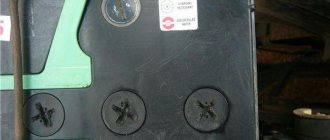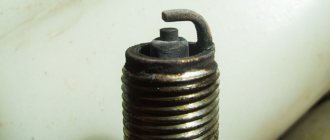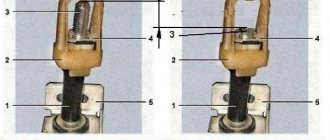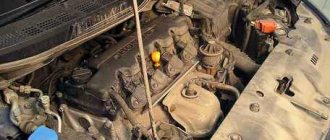The service life of a gel battery, according to manufacturers, is at least 10 years. In practice, the need to repair or replace it becomes obvious after 3-4 years, when a decrease in capacity is observed or the electrolyte solution dries out. The product belongs to the category of maintenance-free elements, but experienced vehicle owners know how to restore a gel battery at home.
Diagram: what parts does a gel battery consist of?
Fundamental differences between gel batteries
Such batteries differ from lead-acid analogues in a number of technical characteristics and electrolyte composition. The binding solution in it is distilled water with the addition of silica gel, which tightly seals the contents of the case.
This allows you to avoid the fumes of chemicals, which affects the level of environmental friendliness of the device - it can be installed not only inside the car, but also in residential areas. In addition, due to the absence of gas emissions, their re-involvement in the work process is ensured and the service life of the product is increased.
Another advantage of the battery is the ability to place it in any position - on its side or upside down, while acid batteries need strictly vertical fixation.
Advantages of the gel battery design.
Batteries with gel electrolyte do not require deep recharging, charge quickly and maintain a service life in standby mode for 2 years.
Due to the increase in the number of charge-discharge cycles, more intensive use of such products is possible.
Among the negative features of such batteries are:
- Instability to low temperatures. At -50⁰C the electrolyte freezes and becomes brittle.
- Rapid failure when applying voltage above 15 V.
- High price.
What can happen if you charge incorrectly?
A gel battery is a capricious “creation”, and if you apply a voltage of 15 or more volts, it will simply swell, since the battery is completely sealed. In addition, detachment of the electrolyte from the plates may occur. In some cases, gas is even released. Then how to restore a gel battery (6V) is out of the question.
Thanks to its good sealing, any room is suitable for charging the battery, the main thing is to prevent the voltage from increasing. You need to turn off the charger only after the battery is fully charged, not earlier. This is also very important!
How to check a gel battery
If there are no obvious flaws, the device is checked using a voltmeter and a load fork, simulating the operation of the starter for 3-4 seconds. The load is connected after setting the voltage values at the terminals, and then an improvised motor is connected for a short period.
The rate of recovery of the electromotive force is assessed by observing the voltmeter needle, which should rise back.
A rapid drop in current indicates that the battery has almost used up its resource; a new device takes a long time to charge. If no changes occur, the voltage can be increased by gradually adding 5 V. During the operation, you should pay attention to ensure that the temperature of the device does not exceed 40-45⁰C.
Scooter battery maintenance
There are 2 types of lead-acid batteries for motorcycles:
batteries are sold in a charged and dry-charged state. Gel types have also appeared that do not require battery maintenance.
Preparing a maintenance-free battery for the first start
The first thing you need to do is fill the dry-charged battery with electrolyte. In summer it is enough to bring the electrolyte density to 1.25 g/cm3, and in winter to bring the density to 1.28 g/cm3.
Next, you need to unscrew the caps of the battery cans and very carefully pour electrolyte into them (it is better to do this with gloves and work clothes), you need to fill it so that the electrolyte covers the lead plates by 1-1.5 cm, but not to the very neck.
Now the simple procedure of recharging the battery is completed and after two hours you can use it. Please note that the battery will initially only be charged to 60-70%, but this is enough to start the scooter.
Is the gel recoverable?
The basis for battery restoration is the drying of moisture in the electrolyte. To check the liquid level in the cans, open the battery cover with a knife or other sharp instrument. When returning the cover to its original position, you must ensure that there is no dirt on the valves.
Because of this, they may not close, and the gel will dry out faster. In addition, the integrity of the device case and its contents is taken into account. The amount of charge stored in the battery must be at least 30% of the required value.
Marking of gel batteries
The label that is placed on the top or side of the battery will tell you a lot. The main characteristics (capacity, starting current), as well as the production date, will necessarily be present here. True, the latter is most often present in encrypted form, and manufacturers are capable of coming up with the most exotic encryption methods. For example, batteries under the Optima brand use four digits, the first of which indicates the year (for example, 8 is 2018), and the remaining three indicate the day of the year (of which there are 365). So you will have to determine the month and date with a calculator in hand.
But at least everything is clear here, but a code consisting of two letters and two numbers is applied to the Delta battery. There are no problems with the latter - they indicate the day of the month, the month can also be determined by the letter (A - January, B - February, and so on), but the year cannot be determined simply by the letter - you need to look for a correspondence table.
A not entirely clear coding is also used in Varta batteries: the fourth digit indicates the year, and 5–6 indicates the month, with values from 17 to 20 indicating January–April, and May starts from 53 and then goes up.
Other manufacturers have a similar situation, and all because of the lack of labeling standards (they exist, but they are different for Europe, Asia, and the USA).
Basic rules for safe charging
The gel battery can be charged at home. The main thing is to ensure the supply of direct current. The procedure is carried out using a 12V charger, which is used only for gel devices.
You can make such chargers yourself. What distinguishes them from other products is the ability to control the incoming voltage. It is recommended to set this indicator at 0.1 of the battery power, the charging time will be about 12 hours. A device designed for acid-type devices cannot be used.
The battery is fully charged and is not used at a low energy level.
A long stay in a discharged state leads to a decrease in capacity. Regularly recharging the battery will prevent this situation.
Long charging
When this procedure is successfully completed, replace the caps and close everything with the outer cover. It is advisable to place a weight on the lid so that the caps are held by it, because During charging, excess pressure is released through them due to the release of hydrogen.
And now we have smoothly approached connecting the “patient” to recharging. How to revive a gel battery using a charger?
Due to the fact that the electrolyte has dried, the battery will not accept current from the charger, because it has lost capacity. You need to start charging with at least 15 volts. We need the battery to start consuming current, and this usually takes a long time. However, if after 14 hours the ammeter has not changed its readings, we raise the voltage to 20 volts. Don't leave this battery unattended! The electrolyte will be reduced and extremely high current will flow through it, which can lead to heating and fire!
How to restore a battery
The process of restoring a gel battery.
Gel batteries are more demanding to maintain, so refurbishing them requires great care. The following tools are used during the procedure:
- syringe;
- tweezers;
- screwdriver;
- Charger.
To restore electrolyte levels, you will need distilled water, which can be purchased at a pharmacy.
Filling distillate
The battery is disassembled by removing the top cover, after which the rubber valve caps are removed with tweezers. Then use a syringe to add 2 ml of distillate to each jar. The liquid must be added gradually as the water is absorbed into the gel. The restored level should completely cover the lead plates, and excess moisture is pumped out with the same syringe.
In some cases, instead of distilled water, electrolyte is poured into the battery. This will work if the battery is old and needs to be revived temporarily.
Recovery using long-term battery charging
After adding distilled liquid, the valves are returned to their place and closed with a lid, which is fixed with tape or glue, and a load is placed on top. This is necessary in order to prevent the valves from breaking due to the released gas.
When connecting the battery to the charger, set the voltmeter to 14-15 V and wait until the battery restores current consumption (within 14 hours). If this does not happen, the voltage is increased to 20 V.
It is important not to leave the battery unattended, since restoration of the electrolyte leads to a sharp drop in load and can cause smoke and burnout of the device. Therefore, as soon as current flows, the level of electromotive force is reduced to 14 V and the battery continues to be charged in the standard mode, i.e., with a charge equal to 0.1 of its nominal capacity.
Cyclic charging
The method is used for severe loss of capacity. It involves 3-4 repeating cycles of charging and discharging.
The first two are carried out under a high voltage of 25-30 V, which gradually decreases to 14 V as current consumption increases. For discharge, a 5-10 W light bulb is used, and care must be taken that the potential difference does not fall below 10, 5-11 V.
After recovery, the battery is charged in standard mode. If it is not possible to return full power to the battery, it is used with an incomplete charge or a new model is purchased.
Checking the electrolyte level
According to the manufacturers, the advantage of a gel battery is that it maintains the electrolyte level throughout its entire service life. This is not always the case, since higher levels of current are supplied to the terminals of the device during the charging process or water evaporation from the gel structure does occur. The internal composition of the cans between the electrodes becomes drier over time, losing the ability to cover the cathode and anode area, which leads to a drop in capacity.
To check the electrolytic level, you need to look at the indicators, if any, or open the lid with caps yourself. If there is a decrease in the volume of the gel, it should be replenished. The process involves adding distilled water to the structure of the gel-like mass. The most important thing is the gradual introduction of liquid with constant monitoring of the coverage of the electrodes with moisture.
The average time for distillate to be absorbed into the gel is from half an hour to 40 minutes. At this frequency, the electrolyte level should be re-checked and water should be added again if necessary. If a layer of pure distillate forms on the surface of the gel, it should be removed as this may have adverse effects on the battery. Upon completion of the work, the inside of the battery is again sealed with the old cap. To ensure tight contact with the body, double-sided tape or adhesive is used. All caps are reinstalled.
How to extend the device's operating life
Application of GEL (Gelled Electrolite) and AGM (Absorptive Glass Mat) technologies for the need to maintain a gel battery.
The service life of a gel battery depends on the operating conditions and care of it. It is not recommended to allow the battery to completely discharge.
If this happens, use a limited charge replenishment scheme - not 10%, but 5% of the declared capacity - and double the process time. The loss of energy intensity during such actions is less than with the standard method.
To avoid such situations, you should purchase a multimeter. For preventive purposes, they regularly check the correct fastening of the terminals and perform a full battery charging cycle once a quarter.
Characteristics of GEL batteries
If you decide to purchase a gel battery, pay attention to the following basic characteristics:
- nominal capacity. In principle, the same restrictions apply here as for acid batteries: it is not advisable to buy a product with a smaller capacity than indicated in the technical documentation of your car. More is possible, but within 5–10 A* hour;
- cold crank current. There are no upper or lower limits, and the higher the indicator, the better. Of course, devices with high cold cranking currents cost a lot and take longer to charge, but they are guaranteed to start the engine in the most severe frosts;
- starting current is an indicator that demonstrates how many amperes the battery is capable of delivering for 30 seconds;
- on some models, the self-discharge current is indicated, which allows you to estimate how long during inactivity the battery will be discharged to dangerous values that do not allow starting the engine;
- The voltage rating for passenger vehicles is standard 12 V;
- the weight and dimensions of the battery must correspond to the dimensions of the battery pad in the engine compartment;
- You also need to pay attention to the polarity of the battery, as well as the type of fastening.
In what cases is battery restoration inappropriate?
Batteries are disposed of:
- When the cans swell, which is caused by the detachment of the gel from the plates. Such a defect is determined visually.
- When the contents of the case are destroyed as a result of prolonged exposure to high temperature. If during inspection of the battery there are extraneous sounds coming from it, the element cannot be “revived”. You can also enlighten the holes of the cans and make sure that the lead plates have lost their original appearance.
The right decision in this case would be to buy a new gel battery.
mission Impossible
Unfortunately, or maybe, on the contrary, fortunately, there are times when it is not possible to restore a gel battery. One of these irreversible faults is when the electrolyte begins to peel off from the plates.
Or they may begin to break down. If this happens, then this also negates all attempts to revive the product. It is not difficult to detect such a malfunction - just shake the battery, and you can hear a noise coming from inside. The presence of a crack is also an unpleasant sign. How to restore a gel battery (12V) if available? The answer is simple: no way.
Principle of operation
Before you begin restoring gel batteries, you need to understand in detail the principle of their operation and the main differences from other types of batteries. In essence, it is somewhat similar to that used in sealed acid-type devices. However, experts mention two main differences.
A special gel-like substance is used as an electrolyte, which consists of purified water and sulfuric acid, which influenced the appearance of the characteristic name. Many car owners attribute the name “helium” to the systems, although this is not entirely correct, since they do not operate on gas.
Overcharging of such devices is unacceptable, because it causes a rapid loss of capacity. To avoid such consequences, it is advisable to maintain a voltage range of 14-16 V.
general description
Currently, gel batteries are widely distributed in various retail outlets, where they offer a wide range of spare parts for various vehicles. However, many people still do not know what the device is, how it works and what benefits it has. The fact is that externally the battery is not much different from its close cousins that run on acid.
For many years, old wet batteries have been in great demand. We are talking about acid models. However, as modern batteries developed, humanity began to actively abandon old, not entirely environmentally friendly systems, giving preference to improved modern developments.
Initially, such devices were developed exclusively for military transport, including aviation, where conventional batteries could not perform their task because they constantly overheated and lost capacity. As a result, they quickly failed and were no longer suitable for further use. Soon new inventions appeared on the market - gel analogues , which quickly occupied a leadership niche and began to gain popularity.
What is the difference
The main feature of a gel battery is its tightness and a special jelly-like electrolyte. The gel composition was recognized as the best solution for a sealed structure. In a conventional automotive power source, the electrolyte participates extremely violently in chemical reactions - vapors are released, and sometimes boiling occurs. The sealed structure may explode if chemical reactions occur with violent release of vapors. To eliminate this effect, gel solutions used a special viscous electrolyte composition and a design that ensures self-absorption of released gases. The user may not even realize that he is the owner of a gel battery - after all, he will not be able to look inside without breaking it. Gel devices, due to their high output current, enjoy increased attention among lovers of powerful audio systems.
Summary
Chemical sources of electric current, which include lead-acid, are in a state of constant improvement. Gel batteries are the next stage of this development. Gel batteries are ideal for use in transport on extreme or sports routes, for owners of powerful audio systems. They performed well at high current loads and have an impressive service life. If necessary, you can restore a tired gel battery by applying cyclic voltage.
Advantages
- Autonomous operation, without monitoring the level and quality of the electrolyte;
- In the event of a leak, the viscosity of the electrolyte prevents leakage;
- Tightness prevents the release of chemical reaction products into the surrounding space;
- Operation allows any position, including upside down;
- Long resource and service life;
- High current level;
- Acceptability of use in residential premises (does not emit fumes);
- Withstands repeated charging and discharging.











